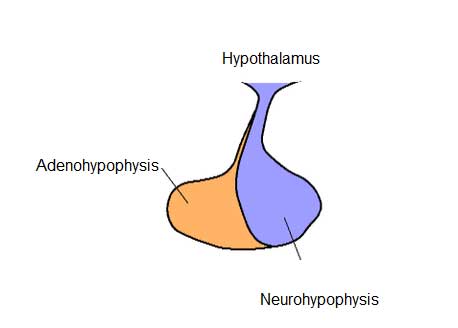Hypophysis or the pituitary gland of human is small pea-shaped gland weighing about 0.5 gm which makes up 80 percent of the gland’s overall weight. It is located under the brain, just behind the bridge of the nose between the hypothalamus and the pineal gland. Hypophysis or the pituitary gland consists of the following two parts: 1. Adenohypophysis or anterior lobe and 2. Neurohypophysis or posterior lobe

Pituitary Gland Showing Neurohypophysis
Neurohypophysis
It is the neural part which develops from the base of the brain and remains connected with each other. It consists of:
- pars nervosa – the chief part
- Median eminence-the upper expanded part of neural stalk and
- Infundibular stem. Anatomically, the pars nervosa and pars intermedia are together known as posterior lobe of the pituitary gland.
Histologically, three parts of the neurohypophysis are composed of similar tissues. They consists of (i) numerous unmyelinated nerve fibers (ii) pituicyte- the branched cells (iii) nerve cells of different types, (iv) mast cells (v) blood vessels and (vi) hyaline bodies.
Hormones of Neurohypophysis
The posterior pituitary gland or neurohypophysis releases two specific hormones which are collectively known as neuro-hormones. The name of neurohypophysis hormones, sources, nature and their functions are stated below:
Hormone 1: Vesopressin or ADH (antidiuretic hormones) or arginine vasopressin ( AVP)
Sources: It releases from the supraoptic nucleus in the hypothalamus.
Nature: Protein nature and contains nine essential amino acids.
Functions
- It increases re-absorption of water from the renal tubules and decreases the volume of excretory urine (antidiuresis) with small dose.
- It causes diabetes insipidus due to lack of vasopressin.
- It stimulates and contracts all the voluntary muscles in the body.
- It also stimulates plain muscles of urinary bladder, ureter, intestine, uterus, etc.
- It raises the blood pressure by causing arteriolar and capillary constriction.
Hormone 2: Oxytocin
Sources: It releases from the paraventricular nucleus in the hypothalamus.
Nature:Protein in nature and contains nine amino acids.
Functions
- It enhances during the late period or pregnancy.
- It contracts pregnant uterus and also helps in parturition.
- It also contracts lactating mammary gland of breast.
- It helps in ejection of accumulated milk in the gland`s alveoli with small dose.
- It helps in transport of sperm in the genital tract.
